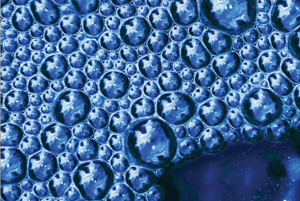Question:
What is the role of detergents in the study of membrane proteins?
The Protein Man Says:
Detergents are amphipathic molecules that can be used to extract, solubilize, and manipulate (disrupt or form) membrane proteins from biological membranes for subsequent biochemical and physical characterization. In addition, detergents can be used to control protein crystallization, prevent nonspecific binding in affinity purification and immunoassay procedures, and act as additives in electrophoresis.
 While these substances may look deceptively simple, they exhibit complex behavior as they associate and interact with other molecules. As such, detergents can be the researcher's friend and foe, both at the same time. However, by understanding how they work, you can use them to better understand the structure and function of membrane proteins.
While these substances may look deceptively simple, they exhibit complex behavior as they associate and interact with other molecules. As such, detergents can be the researcher's friend and foe, both at the same time. However, by understanding how they work, you can use them to better understand the structure and function of membrane proteins.
How do they work?
Due to their unique structure, detergents can act as excellent solubilizing agents. They have a polar, hydrophilic (water-loving) head group which extends from a long hydrophobic (water-fearing) tail. In aqueous solutions, the hydrophilic heads interact with the hydrogen bonds of the water molecules while the hydrophobic tails aggregate to form highly organized spherical structures called micelles upon reaching a certain concentration (known as the Critical Micelle Concentration or CMC). In non-aqueous solutions, detergents form reverse micelles instead.
The average size and shape of micelles is affected by the type, size, and stereochemistry of the surfactant and the solvent environment. And although the concentration of micelles increases as you add more detergent to the solution, the concentration of detergent monomers stays constant above the CMC.
So, how do they solubilize protein membranes? As you may already know, biological membranes have the same amphipathic properties as detergents. They have a charged polar head connected to two hydrophobic tails and form a bilayer (the hydrophobic tails are sandwiched between two faces of polar head groups). Found between these layers are your proteins and lipids.
You cannot release these proteins in aqueous solutions since they are tightly held in the lipid bilayer by the hydrophobic interactions between the lipid tails and hydrophobic protein domains. However, you can extract your target proteins by using the most appropriate detergent solution.
At low detergent solutions, the detergent molecules penetrate the lipid membrane and begin partitioning the lipid bilayer. At higher concentrations (equal to or higher than the detergent’s CMC), the detergent molecules saturate the lipid bilayer and solubilize both the hydrophobic and amphipathic molecules in the solution. This results in the formation of water-soluble protein-detergent complexes, detergent and detergent-lipid micelles.
Surfactant solutions may also exhibit phase behaviors which may include self-association and crystallization. The cloud point, or the temperature when a clear, homogeneous detergent solution becomes cloudy and separates into two immiscible solutions (one detergent-rich while the other is detergent-poor) is still being used for membrane protein purification.
Classification and Characterization of Detergents
Basically, detergents fall into one of three categories (ionic, non-ionic, and Zwitterionic) and their behavior are often determined by the characteristics of the head group and tail.
Ionic detergents are generally used when the complete disruption of cellular structure and denaturation of proteins is desired. This type of detergent binds with protein molecules and renders them the overall charge of the detergent. Using certain buffer conditions, various detergents can effectively penetrate between the membrane bilayers at concentrations sufficient to form mixed micelles. Some common examples include the anionic detergents sodium dodecyl sulfate (SDS) and deoxycholic acid, sodium salt or deoxycholate, and the cationic detergent hexadecyltrimethylammonium bromide (CTAB).
Non-ionic or non-denaturing detergents have an uncharged hydrophilic head group and are commonly preferred in isolating biologically active membrane proteins because of their ability to break lipid-lipid and lipid-protein interactions without disrupting native interactions and structures of water-soluble proteins. They merely associate with the hydrophobic parts of membrane proteins to render them soluble. Some common examples include the Triton, Tween and Brij series.
Zwitterionic detergents protect the native state and do not alter the native charge of the protein molecules. These detergents are ideally used for isoelectric focusing and 2D electrophoresis.
Synthetic zwitterionic detergents are known as sulfobetaines, a group of substances which retain their zwitterionic characteristics over a wide range of pH.
The use of detergents is essential in solubilizing and purifying membrane proteins. This is of utmost importance since membrane proteins remain to be one of the challenging yet one of the least understood areas of the proteosome. As such, by understanding the different detergent parameters, we can expect to gain continued understanding of integral membrane protein.






